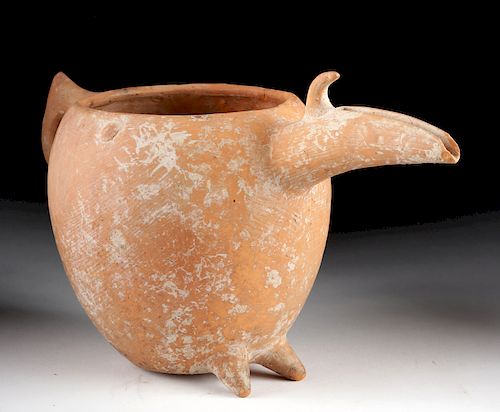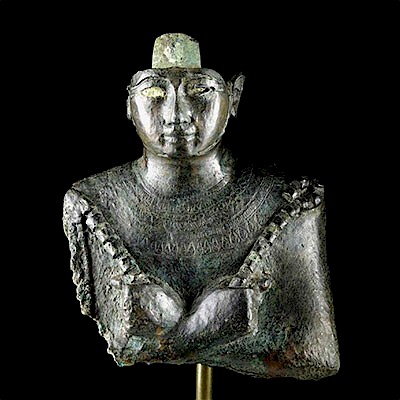Amlash Pottery Zoomorphic Pitcher
Lot 70
About Seller
Artemis Fine Arts
686 S Taylor Ave, Ste 106
Louisville, CO 80027
United States
Selling antiquities, ancient and ethnographic art online since 1993, Artemis Gallery specializes in Classical Antiquities (Egyptian, Greek, Roman, Near Eastern), Asian, Pre-Columbian, African / Tribal / Oceanographic art. Our extensive inventory includes pottery, stone, metal, wood, glass and textil...Read more
Estimate:
$2,000 - $3,000
Absentee vs Live bid
Two ways to bid:
- Leave a max absentee bid and the platform will bid on your behalf up to your maximum bid during the live auction.
- Bid live during the auction and your bids will be submitted real-time to the auctioneer.
Bid Increments
| Price | Bid Increment |
|---|---|
| $0 | $25 |
| $300 | $50 |
| $1,000 | $100 |
| $2,000 | $250 |
| $5,000 | $500 |
| $10,000 | $1,000 |
| $20,000 | $2,500 |
| $50,000 | $5,000 |
| $100,000 | $10,000 |
| $200,000 | $20,000 |
About Auction
By Artemis Fine Arts
May 22, 2019
Set Reminder
2019-05-22 10:00:00
2019-05-22 10:00:00
America/New_York
Bidsquare
Bidsquare : Exceptional Day 1: Antiquities Asian Fine Art
https://www.bidsquare.com/auctions/artemis-gallery/exceptional-day-1-antiquities-asian-fine-art-4129
Day 1 of an important 2-day auction featuring exceptional art from around the world - Egyptian, Greek, Etruscan, Roman, Viking, Russian, Near Eastern; Asian Art from China, Japan, Thailand, Vietnam, Burma, India; Fine Art from the 17th century to present. Artemis Fine Arts info@artemisfinearts.com
Day 1 of an important 2-day auction featuring exceptional art from around the world - Egyptian, Greek, Etruscan, Roman, Viking, Russian, Near Eastern; Asian Art from China, Japan, Thailand, Vietnam, Burma, India; Fine Art from the 17th century to present. Artemis Fine Arts info@artemisfinearts.com
- Lot Description
Persia, Iran, Amlash, ca. 11th to 9th century BCE. A large long-spouted orange terracotta vessel, the spout modeled after an animal head, perhaps belonging to a long-horned antelope or goat-like creature; however, this form has also been interpreted as a long-beaked bird. A single handle with a point perhaps mimicking a tail is at the opposite end; twin circular bosses set 90 degrees from the spout and handle adorn the shoulder of the rounded body, and two conical legs emerge from the base below the zoomorphic spout. Size: 9.25" W (handle to spout) x 5.8" H (23.5 cm x 14.7 cm)
Amlash pottery is known for abstract representations of animal figures. Traditionally, animals native to that region such as ox, ram, horse, boar, stag, and ibex are depicted. Anthropomorphic depictions representing either deities or human beings have also survived. Amlash vessels were buried in large megalithic tombs, built by part of the Marlik culture. Despite its proximity to the large Mesopotamian cultures, the geographical barrier of the high Zagros and Elburz Mountains kept it relatively isolated and a very unique ceramic tradition developed there. This is an elegant example of a grave good that, based on how few graves have been found in the Amlash assemblage, seems to have been reserved only for high status individuals.
Provenance: private East Coast, USA collection; ex-William Froelich collection, New York, USA, acquired in the 1980s
All items legal to buy/sell under U.S. Statute covering cultural patrimony Code 2600, CHAPTER 14, and are guaranteed to be as described or your money back.
A Certificate of Authenticity will accompany all winning bids.
We ship worldwide and handle all shipping in-house for your convenience.
#146175A small triangular section of the rim reattached. Opposite this (on the other side of the handle) is another section of repair with radiating stable fissures and a small area of restoration. Otherwise in very good condition. Wonderful root marks and mineral deposits.Condition
- Shipping Info
-
All shipping is handled in-house for your convenience. Your invoice from Artemis Gallery will include shipping calculation instructions. If in doubt, please inquire BEFORE bidding for estimated shipping costs for individual items.
-
- Buyer's Premium



 EUR
EUR CAD
CAD AUD
AUD GBP
GBP MXN
MXN HKD
HKD CNY
CNY MYR
MYR SEK
SEK SGD
SGD CHF
CHF THB
THB
















